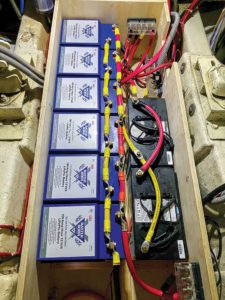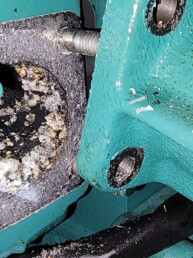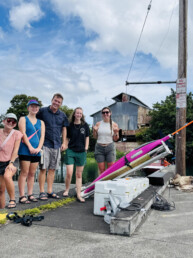Tech Talk with SeaBits
From the February, 2021 issue of 48° North.
Lithium battery systems have become increasingly popular in the last few years, and offer a wealth of benefits for boats. However, there are some considerations that extend beyond the batteries themselves that you should know about for a safe and performant system.
The most common type of lithium battery is LiFePO4, or Lithium Iron Phosphate. They’ve been around for a number of years in the marine world, but where you’re probably more used to seeing them is in consumer electronics. Smartphones, tablets, and laptop computers have used this technology for many years. They are considered very safe if used appropriately, and good marine systems include additional steps to enhance this safety.
One common theme I hear from potential customers is that lithium batteries are unsafe, and that they could melt a hole through your hull or burn your boat down. While there have been examples of this, you can probably find more fires and sinkings of boats from poorly wired electrical systems and other more common problems. There are many systems that could cause a catastrophic issue on a boat, and if installed properly, a LiFePO4 battery has little risk of being one of those systems. Here’s a rundown on types of lithium batteries and some things to keep in mind if you’re considering making the switch.
LiFePO4 Advantages
LiFePO4 battery banks have a few major advantages that are applicable for boating: weight, charging capability, and overall life.
A typical GC2-type flooded battery weighs in at around 60 pounds, and an identical LiFePO4 version is about 30 pounds. The weight savings will equate to lower fuel consumption, and in the case of distributed banks, opportunities for better trim and handling. They’re also a heck of a lot easier to move around!
Using the same GC2 battery, in a flooded cell you’d have somewhere between 200 to 220 amp hours, but only 50-percent of those are usable, resulting in 100-110 total. The same LiFePO4 battery would have about 100 amp hours, the vast majority of which would be usable. So, while you’re not getting more amp hours with lithium, you are getting the same amount in a lighter package.
Charging is where LiFePO4 gets interesting, particularly the higher rates that they are able to accept in general. For flooded batteries, a good estimate is that your maximum charge rate is 20-percent of the overall amp hours. Continuing to use our GC2 battery example at 200 amp hours, and we would be able to charge it at 40 amps safely. The same GC2 LiFePO4 battery could be charged at 100 or even 200 amps (depending on manufacturer and type), which would greatly reduce generator and charging time.
Charging LiFePO4 is also more efficient than a flooded or AGM battery in that there is really no float stage, and the battery can be charged at the maximum amount right up to the final amp hour. If you’ve ever watched your battery charger progress on a flooded or AGM bank, you’re very familiar with the last 10 to 20 percent of capacity taking forever to finish. LiFePO4 doesn’t have this disadvantage and that results in far more efficient and faster charging for that last 20 percent.
The final major reason folks gravitate towards LiFePO4 technology is the overall life, which is a somewhat controversial topic. These batteries are designed to last anywhere from 1,000 to 3,000 cycles depending on the manufacturer, or an estimated lifespan of 10 years based on some calculations. That assumes pristine conditions, good charging amounts, etc. — and doesn’t account for some of the extremes in the boating world. Comparatively, AGM batteries average about 500 cycles and last an average of six years.
Challenges
The biggest challenges in choosing LiFePO4 include price, temperature, charging, and complexity.
Price is likely to be the first hurdle for most boaters when considering LiFePO4. A standard flooded GC2 battery will run you about $175 to $200. A similar GC2 LiFePO4 battery will cost $900 to $950, which is a significant premium. You have to weigh that against the pros above, specifically that of the longer life and higher charging cycles.
Many LiFePO4 batteries are also more temperature sensitive than their flooded and AGM counterparts. That’s not to say that temperature extremes don’t affect those types of batteries — any extremes will dramatically reduce the life of any battery technology. But LiFePO4 in particular do not like super cold or super hot situations, each of which can occur in our engine rooms.
Charging is both a pro and a con, in that while a LiFePO4 battery can take a lot more charging capacity; which means your system has to have that capacity available. Most people have very small chargers or inverter/chargers, and very small alternators as well. Since older battery banks can’t charge that fast, there was no reason to put a 300 amp alternator or a high capacity charger on board. Not only is having the faster charging capability part of the lure of LiFePO4, but many battery manufacturers require you to charge at the higher rates to get the lifetime out of the batteries. As a result, you’re not only paying for a more expensive LiFePO4 battery, you also have to upgrade your charger/inverter and alternator system to gain the benefit of the batteries. For “drop-in” batteries — meaning those that are interchangeable with AGM or flooded batteries — this is not as big of an issue, and one of the reasons why they have become popular.
The final challenge is complexity, and this can be a big one. If you build your own cells or choose a large manufacturer — in addition to upgrading your alternators and charging sources — you’ll likely need to add a battery management system, cut-offs to both load and charge sides to isolate the bank, and generally increase the complexity of the system. With something as critical as your power system, adding more complexity can mean more catastrophic failure modes, and challenges diagnosing problems. That’s not to say that you can’t design a proper system and have it work well, but they aren’t as simple as traditional batteries, and if that is a concern (think ocean crossings without spares) then maybe this approach is not for you.
LiFePO4 Battery Types

There are three main types of LiFePO4 battery solutions: Standard, drop-in, and home built. Standard batteries are made by companies such as Victron, Mastervolt or Lithionics, and are engineered for high performance and monitoring. They require a battery management system (BMS) and are usually the most expensive option available. The benefit of these batteries is the engineering and testing that goes into their performance. However, these batteries require extra equipment for them to work properly, and often times will drive up the cost and installation complexity. They almost always require your inverter or charging systems be modified, and safety systems must be put in place to protect the batteries from being completely discharged. Of the three types, they are the most expensive.
Drop-in batteries are sort of a hybrid between standard batteries and other non-LiFePO4 batteries, in that they don’t require a BMS, and they are easier to adapt to existing systems. Some common manufacturers are Battle Born and Re-Lion. In most cases, they can be “dropped in” to an existing system that had AGM or flooded batteries before and won’t require a lot of other changes. They are usually cheaper than the standard batteries above, and have similar warranties (some are even better) and lifetimes, but potentially slightly lower charge rates.
Home built systems are also extremely popular and have some good benefits. Their cost is usually very low compared to the above solutions, and they can be designed to fit a specific space on board, which is desirable on a space-constrained boat. These batteries are actually a collection of individual “cells” that you purchase, connect together using busses, and create an appropriate level of voltage out of smaller three- and four-volt cells. Because the individual cells of the batteries can be sourced from cheap vendors, you can end up with underperforming or failing components — and it requires a lot of design work to put it all together. These systems require a BMS as well, which can add to the complexity. If you’re looking for a cheaper solution to fit a tight space, home built systems are definitely an option, and there are thriving communities online that can help with your build. But you’ll need basic electrical knowledge (at least) to take this on.
What to Choose?
For boaters looking for a cost effective solution that can reduce weight and expand their amp hours without having to replace much else, look at “drop in” batteries from Battle Born or Re-Lion. There are tons of YouTube videos and articles online about using these batteries, and they work very well — I am currently running 10 of these 100 amp hour batteries myself, and have no complaints.
For the electrical-savvy boater looking for a custom setup to fit smaller spaces or a smaller budget, look at building your own cells and battery management system. There are good forums and groups that can help you get started, but keep in mind you may have some trial and error.
For boaters whose priority is to reduce generator run-time, run even more AC loads while at anchor, and generally expand their power system (and for whom budget isn’t such a concern), a standard battery from Victron or MasterVolt combined with their extensive inverter/chargers and control systems may be a good choice.
Whichever you choose, make sure you consult a marine electrician. The complexity of some of these systems will definitely require a professional to at least review your plan, if not help you design and install it.






